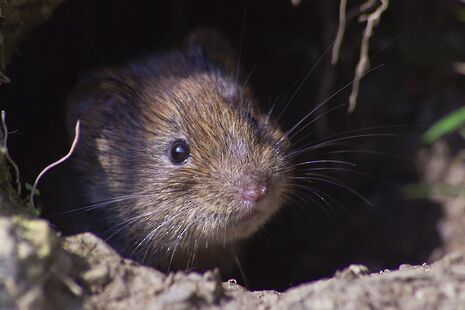Sex, commitment and voles
What can the prairie vole teach us about the origins of human monogamy?

Summer sun is blasting upon us, which means the re-emergence of shorts, pools, sundresses, and (of course) sex. Along with the humidity, questions about dating and relationships permeate the air. “Can we keep this chill?” “Are you my boyfriend?” “What does this mean for us?” The coming and going of the student body leaves many relationships half-realised, and a lot of questions poorly answered.
To satisfy our need for closure, we turn to our friends and families, thinking that their experience will lead to some form of clarity. Maybe someone out there has the ultimate guide to constructing and approaching romantic relationships. What if we’ve all been looking at the wrong place – after all, if animals have it figured out, how hard can it be?
While we’re busy figuring out when’s the best time to bring up exclusivity, animals are looking for the next mate already. For mammals in the wild, monogamy seems to be the odd choice. According to one study, only 5 per cent of all mammalian species are monogamous. Included in that subset is the prairie vole, the model organism for monogamy. These little voles form life-long pair bonds, sharing a nest, grooming each other, cuddling, and raising offspring together – generally showing humans up when it comes to relationships.
Against their promiscuous relatives, the montane vole, the prairie vole brain shows a strikingly high level of vasopressin receptors. These receptors are usually involved in blood clotting and controlling the contraction and dilation of the veins, so it is strange to see their action here. Interestingly, if vasopressin is injected into the montane vole brain, they adopt the monogamous behaviour of their prairie relatives. Remember that cynical acquaintance who always said “love doesn’t exist, it’s just a bunch of chemical reactions”? They might just be right, but a look at our closer relatives sheds more light on the situation.
Unsurprisingly, primates are more similar to humans, with monogamy appearing at a much higher rate of 25 per cent. There are several theories that may explain how monogamy evolved in primates, although all are (sadly) entirely unromantic. One such theory suggests that monogamy evolved as a result of high infanticide risk. In a non-monogamous system, the infant of a previous male mate has a high chance of being killed by the new partner. The male must remain faithful to protect his offspring and ensure his own genetic survival. This is hardly the picture perfect “in sickness or in health” version of monogamy sold to our society.
Even worse still, monogamy is more common among species which are dispersed. This fact alone suggests that monogamy could be the direct result of laziness: once you find a mate, why spend energy finding another one? On top of that, recent discoveries suggest that monogamy may only be a social phenomenon rather than a genetic one. Pairs of animals that are socially bonded may still engage in extra-pair mating when the opportunity arises. Even the poster child of monogamy, the prairie voles, were found to sometimes engage in such adulterous behaviour. Monogamy emerges from these cases more as a necessary survival mechanism than the only acceptable way to conduct a relationship, and perhaps that’s exactly where we went wrong.
It appears that monogamy is, at least evolutionarily speaking, a successful social and reproductive strategy. For humans to choose such a strategy is therefore, in a sense, natural, as it is the historically most successful way to raise children. In fact, monogamy has become so natural that falling in love, getting married, and having kids has become a blueprint to follow.
In following this blueprint humans have changed its meaning. Marriage has become the ultimate sacrificial display of love, spurning every other potential mate in favour of one special person. A grandiose announcement of commitment complete with a virginal white dress, a white picket-fenced house with 2.3 children, a dog, a pool, and a big garden – all of which have nothing to do with why monogamy was successful.
These flourishes have become the definition of a successful relationship, while completely forgetting the humble roots and simple beauty of commitment. Commitment is not about finding the perfect person but rather choosing to build a special bond. The prairie voles are not successful because they are sexually monogamous, they are successful because they build a home together, raise offspring together, and take care of each other.
Sexual monogamy should therefore be the product of a successful relationship as opposed to its definition. The amount of unnecessary emphasis put on monogamy can and has derailed the meaning of relationships as a whole. In nature, there is no benefit to sexual monogamy, only social pair bonding. This is the model from which matrimony evolved, so as long as both partners are dedicated to the relationship they built together, does monogamy really matter?
 News / Fitz students face ‘massive invasion of privacy’ over messy rooms23 April 2024
News / Fitz students face ‘massive invasion of privacy’ over messy rooms23 April 2024 News / Climate activists smash windows of Cambridge Energy Institute22 April 2024
News / Climate activists smash windows of Cambridge Energy Institute22 April 2024 News / Copycat don caught again19 April 2024
News / Copycat don caught again19 April 2024 Comment / Gown vs town? Local investment plans must remember Cambridge is not just a university24 April 2024
Comment / Gown vs town? Local investment plans must remember Cambridge is not just a university24 April 2024 News / Cambridge University disables comments following Passover post backlash 24 April 2024
News / Cambridge University disables comments following Passover post backlash 24 April 2024





